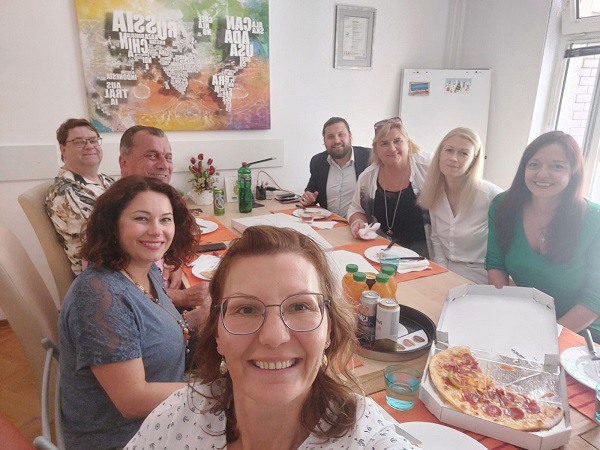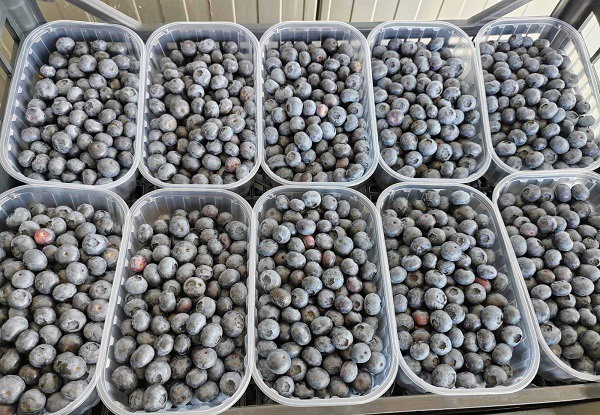With annual production volumes of up to 500,000 tons, damson production plays an important role in Serbia. Among the diverse varieties, Cacak's Early, Cacak's Beautiful (also known as Lepotica) and Stanley stand out as the most widely grown. We spoke with Anneliese Vollweiler, managing director of Anevo Trading GmbH, to gain insights into the industry and recent developments.
"The quality of Serbian damsons is remarkable. Especially the stable ratio between sugar content and water. Compared to other European countries of origin, the Serbian product stands out. Despite challenges such as dry periods and heavy rains with hail and strong winds in the Balkans, harvest volumes are satisfactory. However, some regions have been hit by violent storms and hail, resulting in damage. Nevertheless, demand for Serbian damsons remains consistently high, especially in the fresh fruit sector, jams, plum jams and for the production of fruit distillates, the production of which is increasing, due to the fact that energy costs in Serbia are relatively low compared to other European countries," Vollweiler said.
Variety and origin
Serbian damsons find their way to various European countries such as the Czech Republic, Slovakia, Poland, Austria and southern Germany. The Netherlands, which maintains stable trade relations even after Brexit, is an important customer, he said. Prices for Serbian damsons were rather high compared to goods from other regions due to their good quality. "The fruits are characterized by their firmness, stability and size, which makes them desirable products. The selling prices in the EU per kg for Serbian lepotica were EUR 0.80 to 0.85 dap/ddp. But supermarkets sold the product for 2.49/2.99 EUR per kg; this is much too high in my understanding. Supermarkets with too high margins are inflation accelerators."
Most of the damson packaging is done by hand, using various formats such as 6-kg wooden crates or 10x1-kg units in plastic. "It's worth noting that for the past two to three years, harvest workers from Bangladesh and Pakistan have been working in Serbian agriculture and making a growing contribution to the harvest, as many younger Serbs tend to be drawn abroad."
Serbian damson production has its roots in the Institute of Agriculture and Cacak, which invested heavily in variety development after World War II, Vollweiler knows. "In addition to damsons, other products such as raspberries, blackberries, apples, apricots (apricots) and cherries are also cultivated in Serbia. The variety of growing areas extends from the Voivodina north of the Danube to more southern regions with altitudes of up to 2,000 meters above sea level. Particularly noteworthy is the highest raspberry plantation at 1,350 meters above sea level, which is cultivated exclusively organically in a nature reserve in the Kopaonik region. Here it was possible to motivate young families to revive this rural area - a very great heart project," the managing director tells us.
 The Anevo Trading team
The Anevo Trading team
Lower prices for raspberries
Producers of (frozen) raspberries, in contrast to damson producers, would have a rather depressed mood: "Last year, raspberries were still being sold in part for 7.00 EUR/kg, whereas this year they are being marketed for just up to 2.60 EUR/kg. This is related to the fact that during the pandemic, the U.S. showed a higher interest in Serbian raspberries and producers hoped that EU countries would also accept the prices, but this is not the case. "Especially since the U.S. is now paying more attention to producers from countries such as Chile and Mexico.
Unlike Croatia, which has a better economic situation due to its tourism sector, Serbia is struggling with the challenges of agricultural production, price oscillations and the export market.

The company also markets blueberries in 10 x 400-g units.
Further information: Anneliese Vollweiler
Anneliese Vollweiler
ANEVO Trading GmbH
Fraunhoferstraße 16
D-91058 Erlangen
Telefon: +49 (0) 9131 6108673
Mobil: +49 (0) 170 581 7970
E-Mail: info@anevo.de
Web: www.anevo-trading.com
